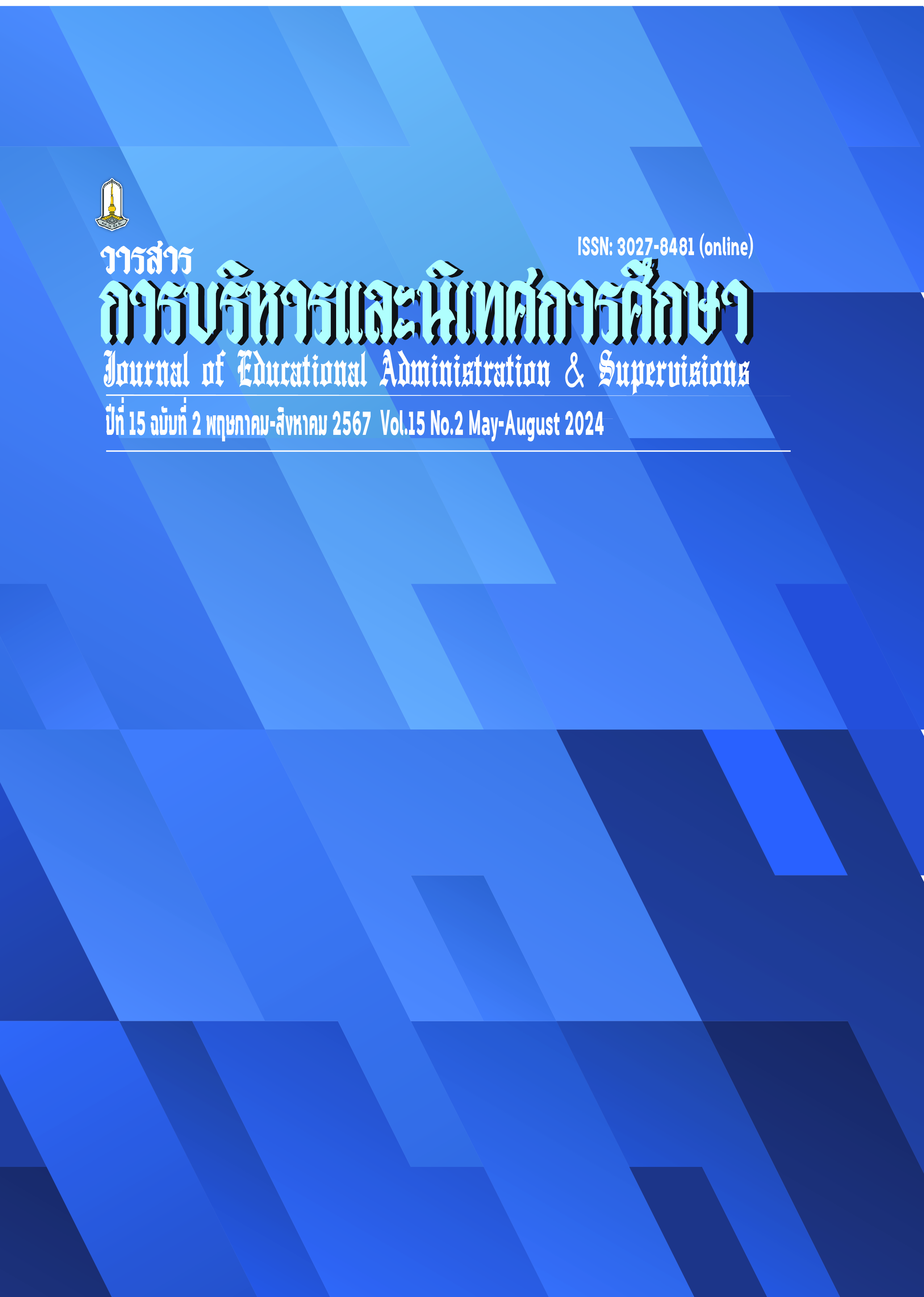ผลสัมฤทธิ์ทางการเรียน ความสามารถในการทำงานเป็นทีม และความพึงพอใจในการใช้แพทเลทเป็นเครื่องมือการเรียนรู้แบบร่วมมือในห้องเรียน: กรณีศึกษานิสิตครู มหาวิทยาลัยบูรพา
Main Article Content
บทคัดย่อ
แพทเลทเป็นแพลตฟอร์มที่ใช้ทำงานร่วมกันออนไลน์เพื่อส่งเสริมการเรียนรู้และการมีปฏิสัมพันธ์ร่วมกันของนักเรียน งานวิจัยนี้ศึกษาการใช้แพทเลทเป็นเครื่องมือการเรียนรู้แบบร่วมมือในชั้นเรียน โดยมีวัตถุประสงค์การวิจัย ได้แก่ 1) เพื่อเปรียบเทียบผลสัมฤทธิ์ทางการเรียนของนิสิตครูก่อนและหลังการใช้แพทเลทเป็นเครื่องมือการเรียนรู้แบบร่วมมือ 2) เพื่อศึกษาความสามารถในการทำงานเป็นทีมของนิสิตครูหลังการใช้แพทเลท และ 3) เพื่อศึกษาความพึงพอใจของนิสิตครูหลังการใช้แพทเลท กลุ่มตัวอย่างได้แก่ นิสิตครูจำนวน 27 คนที่ลงทะเบียนรายวิชาการวิจัยเพื่อพัฒนาการเรียนรู้ ในภาคเรียนที่ 2 ปีการศึกษา 2566 มหาวิทยาลัยบูรพา เป็นการศึกษากลุ่มเดี่ยวโดยวัดก่อนและหลังการทดลอง เครื่องมือที่ใช้ในการวิจัย คือ แบบทดสอบวัดผลสัมฤทธิ์แบบสอบถามความสามารถในการทำงานเป็นทีม และแบบสอบถามความพึงพอใจในการใ ช้แพทเลท สถิติที่ใช้วิเคราะห์ข้อมูล ได้แก่ ค่าเฉลี่ย ส่วนเบี่ยงเบนมาตรฐาน และการทดสอบ Paired Samples T-Test
ผลการวิจัย พบว่า 1) ผลสัมฤทธิ์ทางการเรียนก่อนและหลังการใช้แพทเลทเป็นเครื่องมือการเรียนรู้แบบร่วมมือของนิสิตครูมีความแตกต่างกันอย่างมีนัยสำคัญโดยคะแนนการทดสอบหลังเรียนสูงกว่าคะแนนก่อนเรียนอย่างมีนัยสำคัญทางสถิติที่ระดับ 0.05 2) ความสามารถในการทำงานเป็นทีมของนิสิตครูหลังการใช้แพทเลทเป็นเครื่องมือการเรียนรู้แบบร่วมมืออยู่ในระดับดีเยี่ยม และ 3) ความพึงพอใจของนิสิตครูหลังการใช้แพทเลทเป็นเครื่องมือการเรียนรู้แบบร่วมมืออยู่ในระดับความพึงพอใจอย่างยิ่ง
Downloads
Article Details
เอกสารอ้างอิง
Al Momani, J. A., & Abu Musa, M. A. (2022). A comparative study of the effectiveness of using Padlet in distance learning: Viewpoint of postgraduate students. Journal of Education and E-Learning Research, 9(2), 95–102, https://doi.org/10.20448/jeelr.v9i2.3954
Anwar, C., Nugroho, K. Y., & Nurhamidah, I. (2019). Students’ perception at the use of Padlet in Linguistics class. Journal of Linguistics, Literature, and Culture, 1(1), 35-41, https://doi.org/10.12928/notion.v1i1.714
Arouri, Y. M., Hamaidi, D. A., Al-Kaabi, A. F., Al Attiyah, A. A., & ElKhouly, M. M. (2023). Undergraduate students’ perceptions on the use of Padlet as an educational tool for an academic engagement: Qualitative study. International Journal of Emerging Technologies in Learning, 18(10), 86–106, https://doi.org/10.3991/ijet.v18i10.38771
Boateng, S., & Nyamekye, M. (2022). Learning sciences with technology: The use of Padlet pedagogical tool to improve high school learners’ attainment in Integrated Sciences. International Journal of Learning, Teaching and Educational Research, 21(5), 239–262, https://doi.org/10.26803/ijlter.21.5.13
Chen, Y. M. (2022). Understanding foreign language learners’ perceptions of teachers’ practice with educational technology with specific reference to Kahoot! and Padlet: A case from China. Education and Information Technologies, 27(2), 1439–1465, https://doi.org/10.1007/s10639-021-10649-2
Deni, A. R. M., & Zainal, Z. I. (2018). Padlet as an educational tool: Pedagogical considerations and lessons learnt. ACM International Conference Proceeding Series, 156–162, https://doi.org/10.1145/3290511.3290512
Fuchs, B. (2014). The writing is on the wall: Using Padlet for whole-class engagement. LOEX Quarterly, 40(4), 7–9. https://commons.emich.edu/cgi/viewcontent.cgi?article=1221&context=loexquarterly
Gawin, D. F. (2021). Padlet for project-based learning in an Entrepreneurship course. Journal of Cognitive Sciences and Human Development, 7(2), 175–193, https://doi.org/10.33736/jcshd.3329.2021
Gill-Simmen, L. (2021). Using padlet in instructional design to promote cognitive engagement: A case study of undergraduate marketing students. Journal of Learning Development in Higher Education, (20), 1–14, https://doi.org/10.47408/jldhe.vi20.575
Jong, B., & Kim Hua, T. (2021). Using padlet as a technological tool for assessment of students’ writing skills in online classroom settings. International Journal of Education and Practice, 9(2), 411–423, https://doi.org/10.18488/journal.61.2021.92.411.423
Mahmud, M. Z. (2019). Students’ perceptions of using Padlet as a learning tool for English writing. Journal of Creative Practices in Language Learning and Teaching (CPLT), 7(2). https://cplt.uitm.edu.my/v1/images/v7n2/Article3.pdf
Rulianah, N., Prabowo, A., & Sukono. (2022). Improving students’ learning achievement through cooperative learning and Padlet application in class XI MIPA 3. International Journal of Ethno-Sciences and Education Research, 2(4), 147–151, https://doi.org/10.46336/ijeer.v2i4.355
Shuker, M. A., & Burton, R. (2021). Educational technology review: Bringing people and ideas together with ‘Padlet.’ Journal of Applied Learning and Teaching, 4(2), 121–124, https://doi.org/10.37074/jalt.2021.4.2.9
Srisaat, B. (2017). Preliminary Research. (10th ed). Suwiriyasasana.
Strauß, S., & Rummel, N. (2020). Promoting interaction in online distance education: Designing, implementing and supporting collaborative learning. Information and Learning Science, 121(5), 251-260, https://doi.org/10.1108/ILS-04-2020-0090
United Nations. (2023, 30 May). Goals4: Ensure inclusive and equitable quality education and promote lifelong learning opportunities for all. https://sdgs.un.org/goals/goal4
Waltemeyer, S., Hembree, J. R., & Hammond, H. G. (2021). Padlet: The multipurpose web 2.0 tool. Journal of Instructional Research, 10, 93–99. https://eric.ed.gov/?id=EJ1314149
Wang, Q. (2009). Design and evaluation of a collaborative learning environment. Computers and Education, 53(4), 1138–1146, https://doi.org/10.1016/j.compedu.2009.05.023
Zainuddin, N. M. M., Azmi, N. F. M., Yusoff, R. C. M., Shariff, S. A., & Hassan, W. A. W. (2020). Enhancing classroom engagement through Padlet as a learning tool: A case study. International Journal of Innovative Computing, 10(1), 49-57, https://doi.org/10.11113/ijic.v10n1.250


